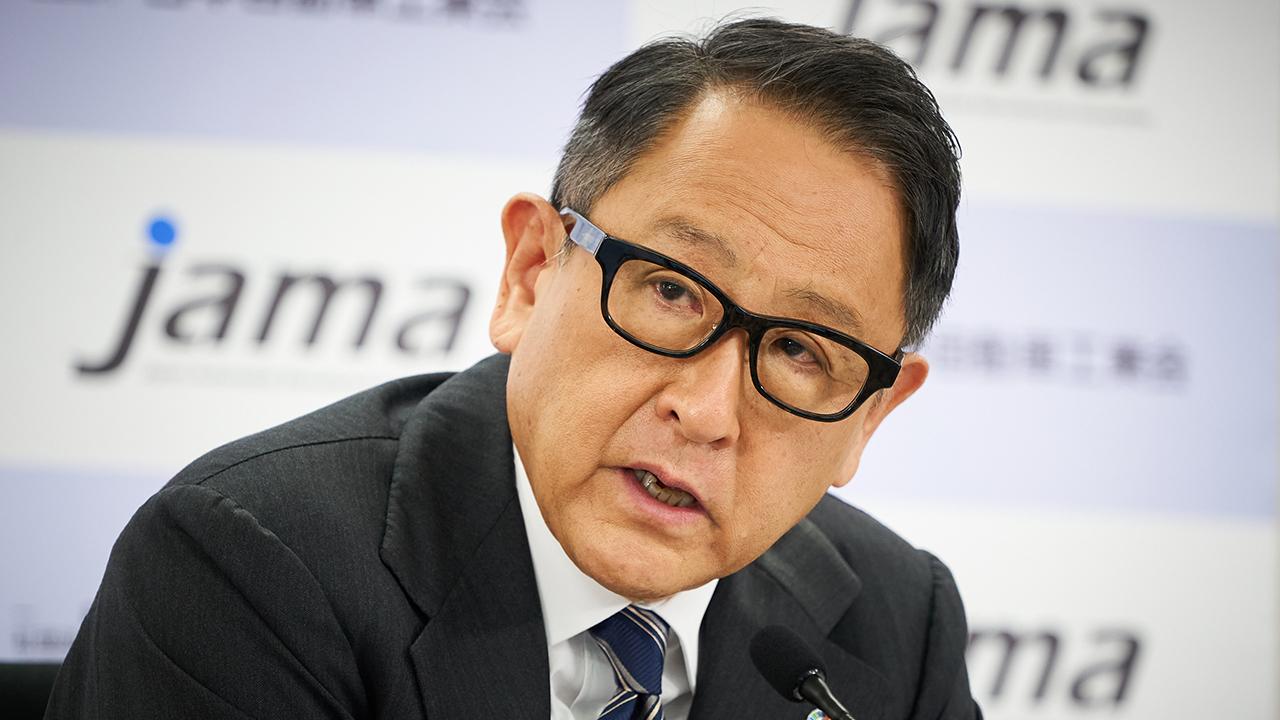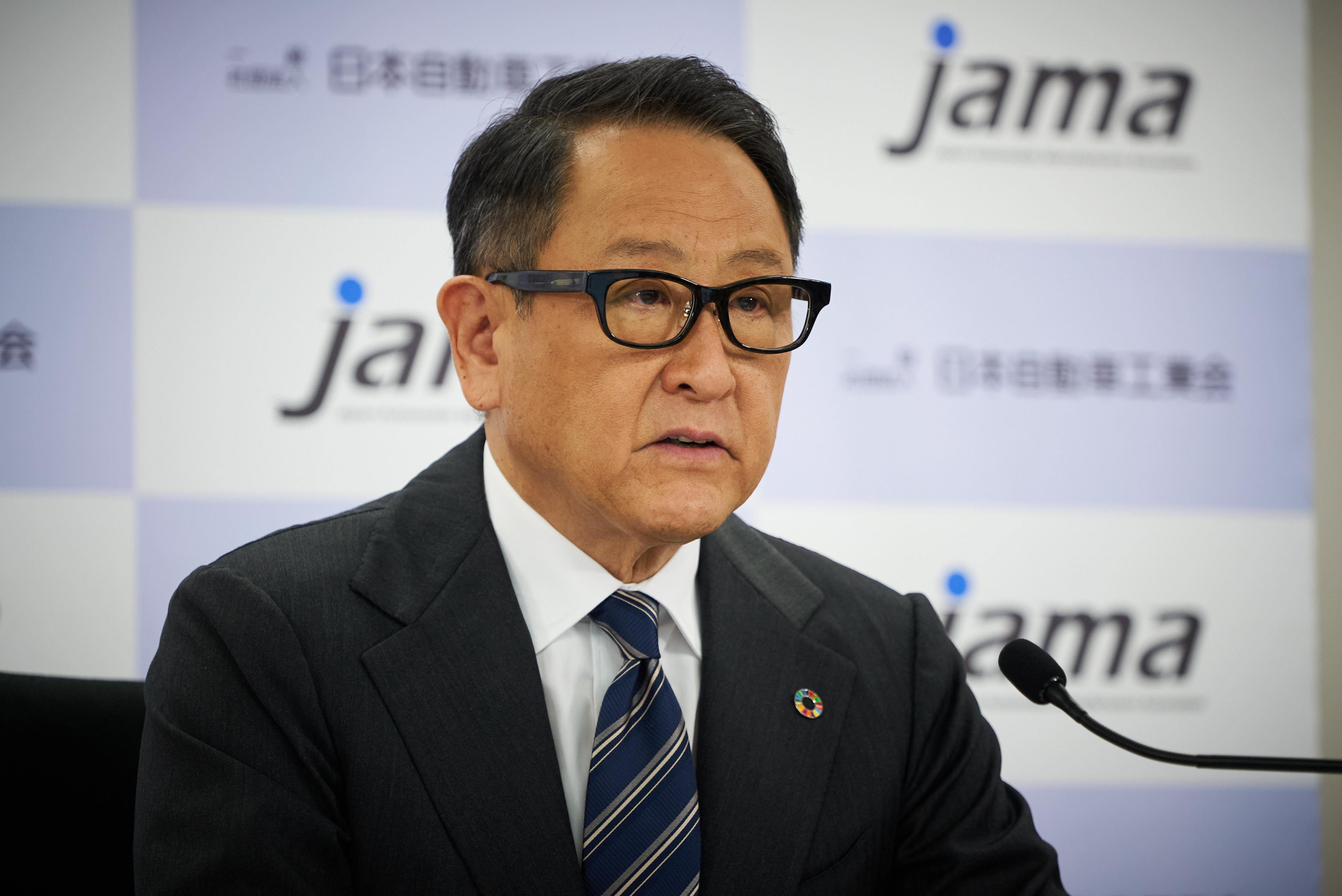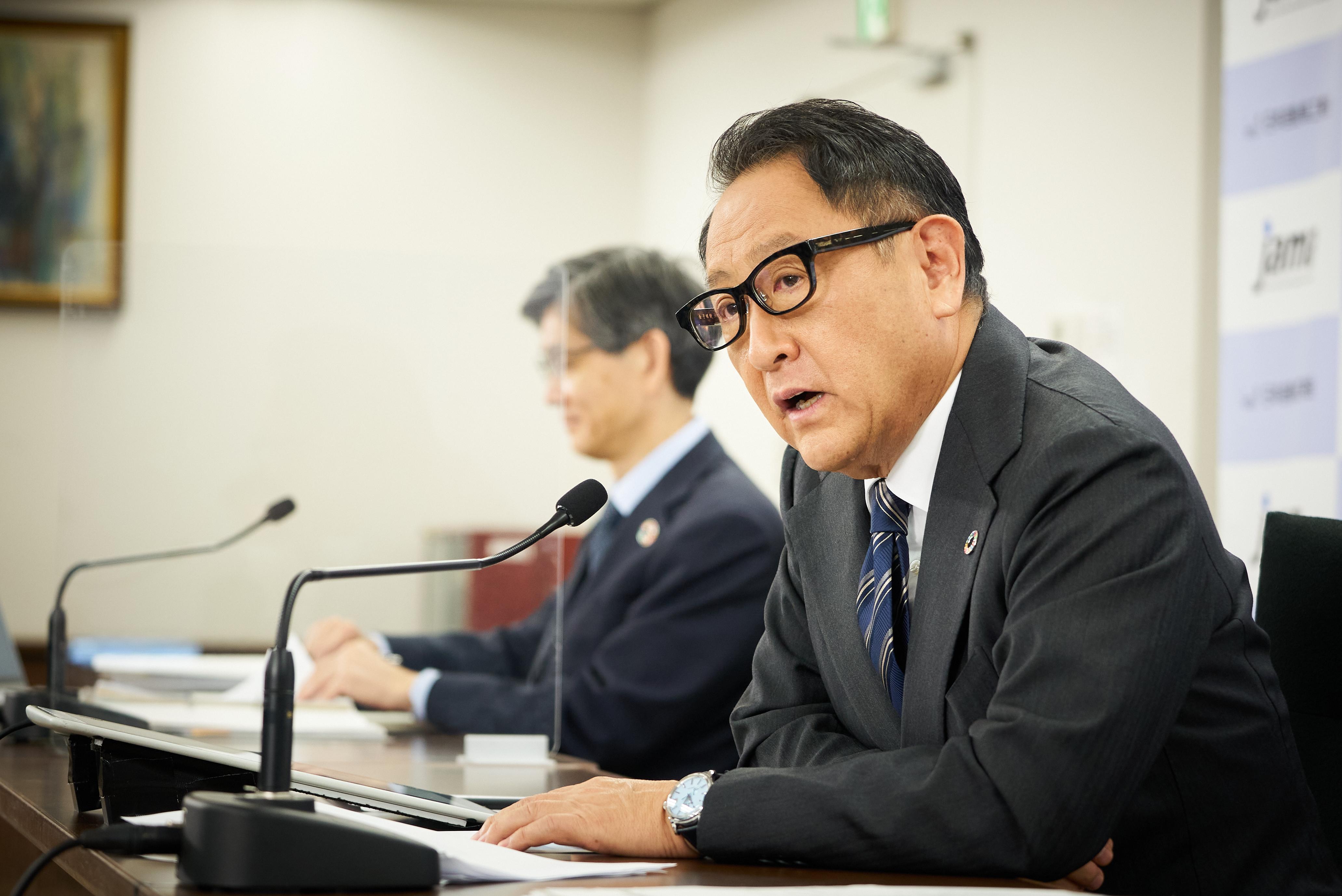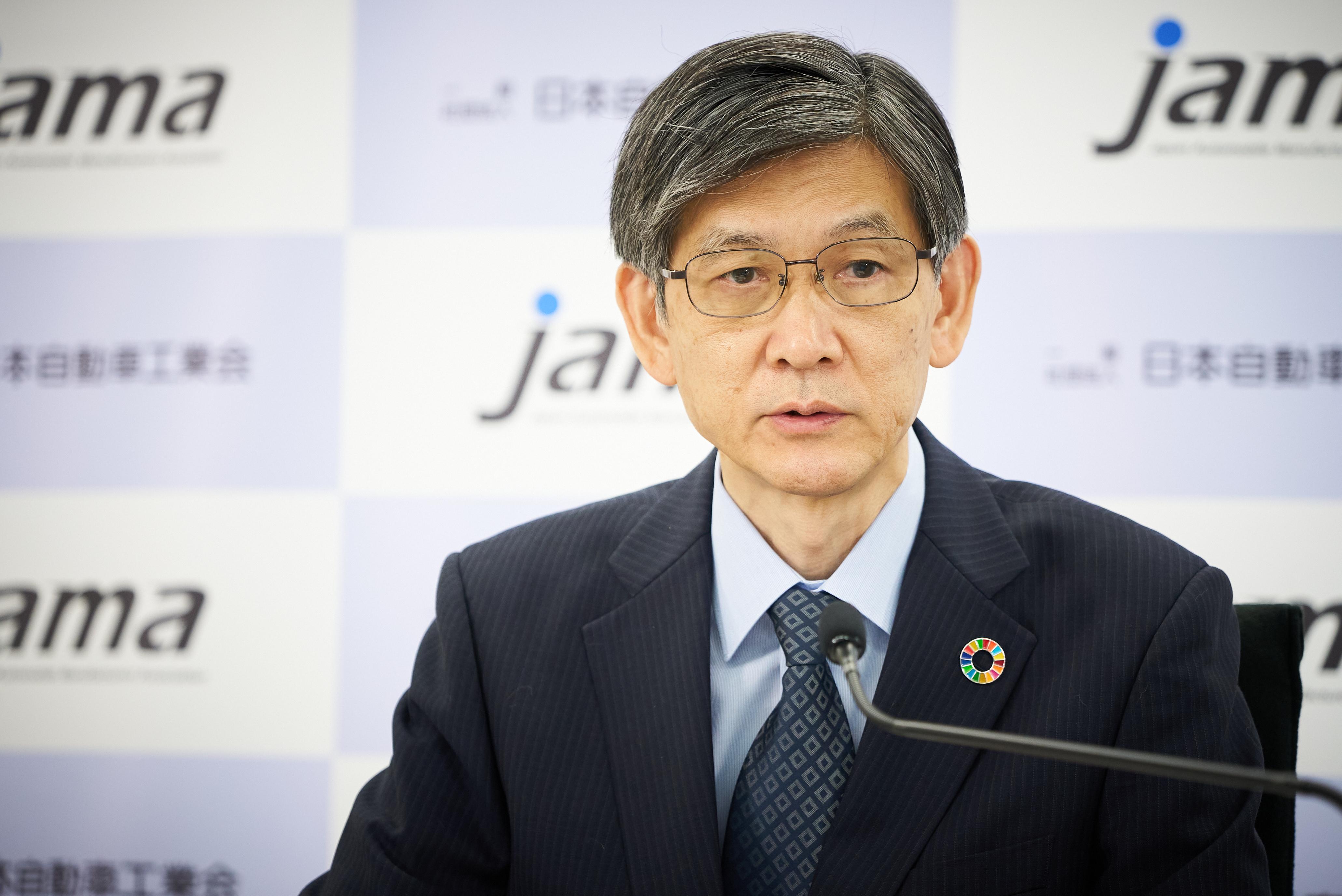
As the JAMA's new leadership structure kicks into gear, Japan's automotive industry takes a new step towards creating a shared future.

The Japan Automobile Manufacturers Association (JAMA) held an online press conference on May 19 after approving the organization’s new executive structure at the Board of Directors meeting. Joining the press conference were Chairman Akio Toyoda and all Vice Chairmen: Masanori Katayama (Isuzu), Toshihiro Mibe (Honda), Yoshihiro Hidaka (Yamaha), Seiichi Nagatsuka (JAMA), Toshihiro Suzuki (Suzuki) and Makoto Uchida (Nissan). Suzuki and Uchida were newly elected.
Chairman Toyoda’s opening remarks focused on the key topics to address under the new JAMA structure.
The greatest challenge is creating a carbon-neutral society
Chairman Toyoda

JAMA officially approved a new executive structure at today’s Board of Directors meeting. Over the six months leading up to this reorganization, we have held regular meetings to develop a deeper understanding of our shared challenges.
We believe that knowing the facts on the ground is the key to accelerating JAMA initiatives. With that in mind, we established a support team with young members from each company who are working together across corporate lines with the guiding principle of Genchi, Genbutsu, Genjitsu (Seeing the facts for yourself).
Today I would like to speak about the priority areas to be addressed by our new leadership team.
We are now making our utmost efforts to address supply chain disruptions due to the pandemic, chip shortages, and natural disasters. We are also faced with the tragic, intolerable reality of the invasion of Ukraine, which has made the global economy’s outlook increasingly uncertain with soaring energy and commodity prices.
I believe we must remain firmly resolved in pursuing reforms for a better future in such times of risk.
Our greatest challenge is creating a carbon-neutral society. Carbon neutrality pushes us to fundamentally change the way we live and to transform the automotive industry, as we have sustained these lifestyles through mobility.
Initially, I too was unsure how to proceed. I began by advocating for a proper understanding of carbon neutrality as the first step.
“Carbon is our enemy, not the internal combustion engine.”
“We must reduce CO2 emissions in all processes of producing, transporting, and using energy.”
“There must be more than one route to reach carbon neutrality.”
“Regulations should not limit our choice of technologies.”
We have backed up these words with various trial projects, sharing what we have learned at every turn. These efforts have helped spread the message, and more like-minded partners have joined our cause.
I believe that carbon neutrality is also a chance for Japan’s automotive industry to hone its CASE technology.
As a growth industry, automobiles need to drive “growth and distribution”
Chairman Toyoda
Advancements in CASE will greatly boost the value generated by cars, including through mobility services deeply rooted in our daily lives.
I believe that the automobile is a growth sector as it is transforming into the mobility industry. It can be a driving force for the Kishida administration’s agenda to achieve “growth and distribution.”
Looking back at the two years of the pandemic, in Japan, we saw 12 trillion yen in capital expenditure and R&D spending, 25 trillion yen in trade income, and 270,000 newly created jobs. We are proud that the automotive industry has helped fuel Japan’s growth.
Similarly, regarding distribution, JAMA companies led the way in generating momentum for higher wages at this spring’s labor-management consultations.
This process also highlighted an important issue. Only 30 percent of workers in the auto industry are represented at the negotiating table. We need to ensure that the benefits extend to the remaining 70 percent not represented by labor organizations.
Neither carbon neutrality nor “growth and distribution” can be achieved without concerted effort. In Japan, we must work together under a national strategy driven by a strong desire to improve society.
To that end, one of the priority areas for this year is automobile tax reform. We will seek robust discussions that do away with the vertical administrative structure and the idea of making changes every two years only.
Japan needs a strategy that both creates new growth paths and accelerates carbon-neutral initiatives, including efforts to tackle our energy challenges. I believe the tax system also needs to be scrutinized within this growth strategy and industrial policy.
This year, we hope to find a way forward through deeper discussions on comprehensive automobile tax reform.
An industry united as one, a future built together
Chairman Toyoda
Next year will also see the return of the Tokyo Motor Show. Last time, inviting participants from outside the industry helped draw 1.3 million visitors, proving that we can attract vast crowds to automobiles by working together with other sectors.
Taking those lessons on board, we plan to name next year’s Tokyo Motor Show the Japan All-Industry Show.
We hope to bring many people together at our event by looking beyond mobility and collaborating with all industries across Japan, including startup companies. Please look forward to a completely new show, revamped in both name and substance.
Finally, I firmly believe that the auto industry stands united as one, and the future is ours to create together.
The strength of Japan’s auto industry stems from automakers offering a full lineup of mobility, from passenger cars to commercial vehicles, minivehicles, and motorcycles.
We will leverage this strength to serve as a pacemaker in carbon neutrality and “growth and distribution.” We want to play a central role in accelerating both efforts.
With purposeful passion, we will work together for the future and the planet. We look forward to your continued support.
JAMA takes concrete action across company lines
Chairman Toyoda’s address was followed by questions from the press. All of the JAMA representatives responded on topics including leadership under the new structure, tax reforms, a depreciating yen, and soaring materials prices. The common thread running through their comments was a sense of the industry “united as one,” as expressed by Akio.
The first question was regarding the team’s ambitions under the new structure.
Chairman Toyoda
As the word “Japan” in our association’s name implies, we have an important role in the Japanese economy and society. And I believe it’s important that we all move forward together in facing today’s difficult challenges.
The JAMA brings together globally competitive manufacturers across the full lineup of passenger cars, heavy-duty trucks, minivehicles, and motorcycles. I believe our new structure has great significance by reflecting this full lineup. It’s important that those who know each area best can lead us in safeguarding and developing the auto industry together.
Over these two years (of our term), we will continue working to strengthen collaboration with four other leading automotive organizations and join together with the industry’s 5.5 million individuals in moving towards the future.
Vice Chairman Uchida
It’s important that all of our member companies continue to push each other forward and enhance corporate value through friendly competition, while uniting to tackle our common challenges.
This is exactly why I proposed establishing a support team (consisting of young members from each company) late last year. They are now working across company lines on industrywide issues, including initiatives targeting “growth and distribution” and automobile taxation.
Many of our current challenges cannot be resolved within the auto industry alone, requiring collaboration with other sectors. Prime examples are carbon-neutral initiatives and our “Japan All-Industry” concept for the Tokyo Motor Show.
Vice Chairman Suzuki
I believe that carbon-neutral and CASE initiatives require a truly collective effort in Japan.
I also believe that minivehicles will play a crucial role not only in supporting people’s daily lives but also in sustaining last-mile transport and contributing to our planet’s future. I want to contribute as a JAMA executive in the minivehicle area to ensure promises are fulfilled.
Next, a reporter asked about the roadmap for future carbon neutrality efforts.
Vice Chairman Mibe went a step further to introduce some of the ongoing initiatives.
Vice Chairman Mibe
We need accurate CO2 emission measuring and monitoring to accelerate reduction efforts for carbon neutrality. Such monitoring entails calculating emissions over the entire lifecycle. We are working together to ensure that Japan can take the lead in establishing international guidelines in this area.
In addition, we have communicated the importance of diverse technology and energy options through the International Organization of Motor Vehicle Manufacturers (OICA), based on a JAMA consensus, ahead of the meeting of the G7 climate and environment ministers later this month.
Vice Chairmen Katayama and Hidaka also shared their existing inter-company initiatives and visions for heavy-duty vehicles and motorcycles.
Vice Chairman Katayama
We produce heavy-duty and light trucks for diverse applications, and technology is advancing at a tremendous rate. Because trucks form part of our customers’ operations, we use monitored vehicles to identify the needs for electrified vehicles on the logistics frontline.
Efforts limited to an individual company would limit the project’s scale, so we are bringing various partners on board to create an alliance in preparation for public trials. Given the enormous impact these changes will have on society, we are working as JAMA to help people see the benefits of electrification in various ways.
Vice Chairman Hidaka
Honda, Suzuki, Kawasaki, and Yamaha are working together in the motorcycle area. In addition to electrifying motorcycles, we must standardize swappable batteries to improve customer convenience, resource recycling, and cost reductions, particularly in the area of scooters for everyday transport.
To that end, the four motorcycle companies have agreed on technical standards. We have worked to ensure that everyone can use the same swappable batteries, helping to speed up infrastructure development. We have also established a new company with ENEOS to promote widespread use of swappable batteries.
Overseas, we have also formed a battery consortium between European and Japanese motorcycle manufacturers. This has spurred discussion of international standardization, within which JAMA is working to make our Japanese standards the global norm.
Seeking shared growth amid competition
Chairman Toyoda responded to a question asking a specific request for tax reforms. “I certainly have a lot to say on that subject,” he said before recapping the history of tax reform efforts.
Chairman Toyoda
To put it simply, JAMA has consistently appealed to alleviate the burden by simplifying the complex and onerous taxes on automobiles.
Some of these requests have been granted, but we have not seen a fundamental revision, with new taxes being introduced to make up for lost revenue sources. We received a perpetual tax cut in 2019 for the first time since automobile taxes were enacted. But still, Japan has the highest taxation in the world.
In Japan, we need a growth strategy, including energy policies, to achieve carbon neutrality. It is crucial to consider how to fit the country’s leading automotive industry into that strategy, and how to protect jobs.
We need serious, robust discussions to establish a new taxation system. Now is the time to redraft a vast blueprint for Japan’s future growth.
That is why we would like Prime Minister Kishida to lead the discussion on growth strategy and Japanese people’s livelihoods, instead of the usual tug-of-war between government ministries.

This was followed by a question about the increasingly weak yen and rising materials prices. Vice Chairman Nagatsuka explained the impact on the auto industry by comparing the currency’s most recent depreciation with past declines.
Vice Chairman Nagatsuka
Since we are an export industry, many people assume that a weaker yen just gives us an advantage. The reality, however, is not so simple.
In normal times, vehicle exports benefit from a weaker yen, helping boost revenues. However, given the current environment, the soaring costs of importing materials and parts amplify the weak yen’s disadvantages.
On the export front, the benefits of a weak yen are undermined as parts procurement difficulties constrain supply. At the same time, soaring prices mean materials and parts imports constitute a far greater cost factor than usual.
In Japan’s automotive industry, we stand as one. Therefore, it is vital that growth is shared, and we continue to distribute gains and give back to all stakeholders.

We plan to work closely with the Japan Auto Parts Industries Association and other tier one companies, monitoring the situation while also addressing the needs of lower tiers. In this industry, we are all in it together, and moving forward we will seek to strengthen resilience across all suppliers.
Carbon neutrality tops a long list of challenges that will require a national response. Automobiles are expected to serve as a pacemaker for the whole industry, as one of Japan’s core industries deeply intertwined with energy, materials, and many other sectors.
In this regard, JAMA’s new structure has far-reaching significance as it brings together the leading companies in all areas to leverage Japan’s strength in offering a full lineup of products.
United as one, Japan’s automotive industry will continue its transformation for a brighter future.

